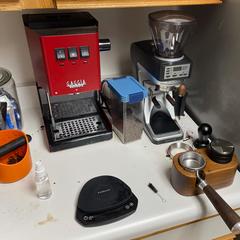Roast note: Burman Colombian Las Montanas EA Natural Process
I finally tried out a roast I’d been looking forward to, a medium-light roast of Burman Colombian Las Montanas, an EA-decaf natural process coffee. This is one of those coffees that tasted so good I just had to record my notes for later.
I used the following roast profile on the Popper*:
- 6:00 at 980 watts
- 1:00 at 1140 watts (at which it barely reached first crack)
- 3:00 cooling cycle
And then it rested for 8 days. The overall mass loss was 10.3%, classifying it as “first crack” according to Sweet Maria’s chart.
The resulting espresso shot was flavorful with a nice level of acid, fruity flavor, a slightly syrupy texture, and a bit of natural sweetness.

